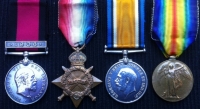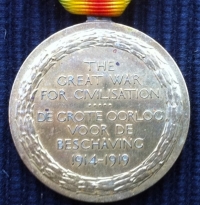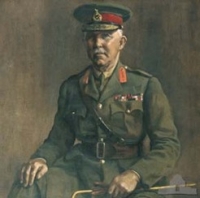An Unusual South African Group
NATAL REBELLION MEDAL MEDAL(1906)
"ROYSTON'S HORSE"
&
1914-1915 TRIO.
1st MOUNTED RIFLES & 7th SOUTH AFRICAN INFANTRY.
To:
TRP(Natal), Sgt (Star), S/Sgt,(Bi-Ling Victory) 2nd Lt,(War Medal)
J.G.P. O'BRYEN. 

A most unusual group.
The recipient having served in three different units at three different ranks !!
Unresearched as as purchased !
£595
ALL ABOUT ROYSTON'S HORSE
 John Robinson Royston,(1860–1942)
John Robinson Royston,(1860–1942)
John Robinson Royston (1860-1942), soldier and farmer, was born on 29 April 1860 at Durban, South Africa, son of William Royston, civil engineer. He was educated at Durban High School where his chunky build and fierce patriotism won him the nickname 'John Bull'. He fought in the Zulu War in 1879 and by 1884 was a sergeant in the newly formed Natal Mounted Rifles. Trading in the Ixopo division of Natal from his farm, St Faith, he employed many Bantu, spoke their language and treated them with firmness and respect.
When the South African War broke out in 1899 Royston was a squadron sergeant major in the Natal Border Rifles. Commissioned lieutenant within a week, he was at the siege of Ladysmith, was prominent in the capture of a Boer field-piece on Gun Hill, and was twice mentioned in dispatches.
What Royston called 'the principal thread of my military career', his leadership of Australian troops, began in April 1901 when, as captain, he took command of the 5th and 6th contingents of the Western Australian Mounted Infantry. Over the next year they saw action in the Eastern Transvaal, Natal and Orange Free State. For the capture of Boer laagers in the Ermelo district Royston was awarded the Distinguished Service Order on 28 January 1902 and later that year was appointed C.M.G., honours which he attributed to the 'courage and soldierly qualities' of his troops.
He led the South African contingent to the coronation of Edward VII in 1902 and on 15 April 1903 married Lilian Earle Heugh; they had a son and a daughter. In 1904 he was made brevet lieutenant colonel of the Border Mounted Rifles, most of his men being Australians who had stayed in South Africa after the war. By 1906 Royston had settled at Kingston, a cliff-top mansion near Port Shepstone, Natal. In the Zulu rebellion of that year he raised Royston's Horse, again composed mostly of Australians, and was mentioned in dispatches. At the coronation in 1911 of George V, Royston was special aide-de-camp to Lord Kitchener.
With the outbreak of World War I in 1914 Royston recruited the predominantly Australian Natal Light Horse and led them successfully against pro-German rebels and German troops invading South Africa, before pursuing the campaign in German South-West Africa. After the surrender of the German forces there, he recruited a new regiment of Royston's Horse and took it to England. He was persuaded to relinquish command and, on Lord Kitchener's orders, travelled to Egypt where Lieutenant-General Sir William Birdwood was to give him 'the first available Australian command'.
Appointed colonel of the 12th Light Horse Regiment, Australian Imperial Force, on 22 February 1916, Royston won the immediate affection and respect of his men, becoming a light horse legend at the battle of Romani on 4-5 August. In temporary command of the 2nd Light Horse Brigade, the 'massively built' 56-year-old Royston galloped around the battlefield with astounding energy and courage, reputedly riding fourteen horses to a standstill.
His nickname, 'Galloping Jack', would stick. Late in the first day's battle a bullet lodged in Royston's calf. Ordered by Major General (Sir) Harry Chauvel to have the wound treated, he galloped off before the dressing was completed, trailing strips of bandage. On the second day of battle Chauvel ordered him to hospital. Royston left within a few hours and the bullet stayed in his leg until his death. Next day the 1st L.H. Brigade was also put under his command for the Bir el Abd operation and on 9 August he took command of the 3rd L.H. Brigade. At the battle of Magdhaba in December he created another legend. Confronting several Turkish soldiers, he flourished his riding cane and ordered 'Hands up' in Bantu. The startled Turks dropped their rifles and surrendered.
During the battle he placed a 22-year-old, Major H. C. H. Robertson, in command of the 10th L.H.R., then galloped off to organize elements of the regiment in an elaborate bluff which climaxed with him personally leading a charge of 'the pack leaders and odds and ends of men who were supposed to be holding the led horses'. Royston emerged as the perfect foil to Chauvel: his high-profile leadership complemented Chauvel's less showy command-style. His love for forlorn-hope attack and the utilization of every man and horse balanced Chauvel's more cautious generalship and his shepherding of reserves. Remarkably, the only decoration received by Royston during his light horse service was the Russian Order of St Stanislaus, 3rd class, with swords.
After leading the 3rd L.H. Brigade in the 1st and 2nd battles of Gaza, Brigadier General Royston abruptly left the light horse in October 1917 on the eve of the Beersheba operations. According to the official history, his departure was 'for urgent personal business'. Royston told his biographer simply that he was ordered back to London. However, Major A. B. 'Banjo' Paterson claimed that Royston had deliberately inhaled poison gas so that he could be sure of recognizing its presence in battle. 'The result was that I found him in a hospital, a badly shaken man, passing green urine, and ordered away for a long leave'. Other sources confirm this unlikely story. Royston was persuaded to return to South Africa from London, 'a very sick man and broken-hearted at having to leave his command'.
After the war he continued raising horses, sheep and cattle and cropping on his many Natal properties. In 1934, when the 8th L.H.R. invited him to Australia for the Victorian centenary and the dedication of Melbourne's Shrine of Remembrance, he received a hero's welcome in four States. In 1937 he led the South African contingent to the coronation of George VI and married Mildred Standly with Anglican rites.
Royston died at Durban on 25 April 1942, survived by his two children and his second wife who wrote that 'he loved his Australians to the last'. And the Light Horse loved him, as they loved no Australian-born officer. Writing of him, the men who knew him best produced strings of adulatory and sometimes contradictory adjectives. Perhaps Paterson came closest with his summing-up that Royston was 'by instinct a bandit chief and by temperament a hero'. As well, the man was vivid, generous, warm, impatient of protocol, careless of detail, single-minded, impetuous and stubborn. He was the stuff that military triumphs and disasters are made of. Fate, and perhaps his beloved Australians, spared him the disasters.